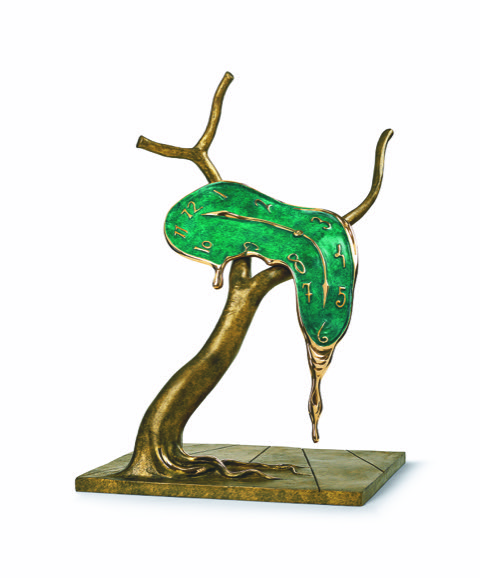Echoing Dalí’s 1931 painting The Persistence of Memory, in which the famous melted watch appears for the first time, this sculpture is an ingenious creation – full of symbolism and hidden meanings. Dalí became obsessed with the flow of time and portrays the clock as soft, a type of symbolism he reserved for those objects he loathed. “The mechanical object was to become my worst enemy, and as for watches, they would have to be soft, or not be at all!”
The soft watch liquefies lamentably over the tree forming a double image. Tilting ones head to the left a hidden image appears; the clock face changes into the artists profile, an eye, a pointed nose and the 9 suggestive of Dalí’s moustache. Dalí enjoyed surprising people and encouraged them to participate in his art.
The shape of limp clock immediately recalls Dalí’s 1929 work The Great Masturbator, a self-portrait with a distorted long head in profile looking downward. This peculiar shape is based on a specific rock formation in his hometown, emphasizing the influence of Dalí’s native landscape in his art, besides the olive tree, another significant image for Dalí.
Dalí enjoyed rotating images, experimenting with malleability; he manipulated and mutated everyday objects to disrupt reality, blurring the boundaries between the unconscious and conscious. The melting clock evokes sensations of timelessness found in the dream world, the watch is fluid, almost sinuous and time becomes meaningless. But there is also a melancholic atmosphere suggestive that time is running out and of man’s constant battle against time.
Date: conceived in 1977, first cast in 1984
Material: bronze
Technique: lost wax process
Edition size : 350 + 35 EA
Height : 51 cm
Edition : patina green
Maquette: original gouache, Profile of Time, 1977
Direct intervention (created by Dalí): the idea, image, and original maquette
Indirect intervention (created by artisans): lost wax process and patina






